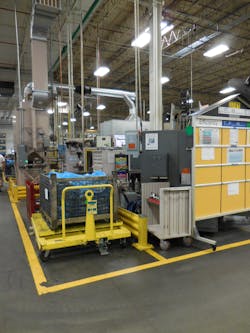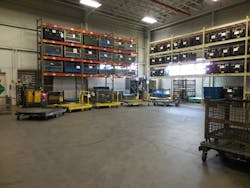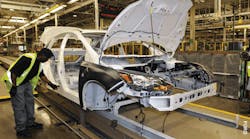Schaeffler describes itself as an engineering partner as well as a supplier to almost all automobile manufacturers, and with the help of LuK, which it acquired in 1999, it provides repair shops, distributors and end customers with the transmission components they need. Way’s plant, located in Wooster, Ohio, builds torque converters for large trucks.
The parent company prides itself on lean practices, and going fork-free is one of those. Way saw this mandate as an opportunity to start using tugger-towed carts instead of forklifts to transport components around assembly operations.
To get started down this road to fewer forklifts, Way purchased a tugger from a local wholesaler for $700. He then bought some carts from a Ford plant which was selling some on ebay. He experimented with capacities and studied the best routes to transport parts through the shop and the most efficient ways to present them to each work center. This do-it-yourself approach to cart sourcing was certainly cheap, but it was costly in other ways—particularly maintenance.
“Bearings and casters were different from cart to cart and there wasn’t good repair consistency,” Way told me. “Whenever we had a repair we had to match the cart to whatever part we had. It wasn’t easy to stock those parts.”
Next, Way approached K-Tec, a provider of custom-designed carts. It designed a new cart for him based on an existing design but shortened it by 6 inches to better fit the tight space tolerances in LuK’s assembly cells.“We had to make sure the carts were not protruding into the aisles and that we weren’t impeding the operators,” Way explained.
Having just written a blog about automated guided vehicles, I couldn’t resist asking him if AGVs entered his thought process. It turns out he considered several types, guided and non-guided. Ultimately, he decided that with all the pedestrian and vehicle traffic required in his operations, AGVs wouldn’t be practical.
Now Way relies on nine tuggers (Linde, Yale and Toyota) to tow his carts, not only to supply assembly stations, but to collect recyclables and trash in his plant. There are seven tugger routes running daily on three shifts, seven days a week. His operations aren’t completely forklift-free, though. Way’s fleet included 20 forklifts, most of which are 5,000 pound capacity, but he also relies on two 8,000 pound capacity models and one 12,000 pound. The larger capacities are used in LuK’s stamping area for handling dies, molds and plates. However, going to carts to feed production has enabled him to get rid of six forklifts.
“Considering our pedestrian traffic, using the tuggers is beneficial,” Way told me. “They’re less expensive. Production operations require much stopping and starting, which meant more wear and tear on forklifts.”
He budgets $300 per month for forklift repairs, PMs and tires.
“The money we put into the tuggers is significantly less,” he continued. “There’s not as much continuous run time as a lift truck, and it’s easier to not keep as much inventory on the floor at the work cells. This affords assemblers more space. We’ve also been able to reallocate some of our resources because of not needing as many material handlers. We put them to work elsewhere in the shop.”
Way’s facility in Wooster is one of three LuK plants in the U.S., the others being in Valley City, Ohio and Troy, Mich; there are also plants in Mexico and Brazil. His location, however, is the first to start the fork-free journey. That journey will continue as his operations expand with a new warehouse which will be ready by 2016. This will mean increased use of tuggers and carts.
“We have budgeted for another 80 carts in 2015, and we’re looking for more tuggers,” he said. “We’re looking at having the material sent into the plant on carts. We’ll only bring material in that we need for two-hour intervals.”The benefits so far have been impressive. Aside from having less material line side, material is presented to assemblers down flow racks, which relieves them of the additional work of part retrieval. They’ve also reduced the distances their remaining forklifts must travel, keeping them in areas where they’re still needed. This saves energy costs.
“When we were running with only forklifts, one of them would go through a bottle of propane on the first shift,” Way explained. “We also had electric trucks prior to this and we still have electric standups. Our trucks are running 7 of the 8 hours a day, and opportunity charging is not an option, so the batteries were changed every shift. That requires 15-20 minutes to change and maintain batteries. When we went with the electric tuggers the timeframe was significantly less, even with having more of them.”
Way says there’s also less training time on the tuggers and that the recertification process is easier.
As this LuK facility gets closer to adding a new warehouse, Way is considering using tuggers with more capacity to accommodate longer hauls pulling more carts—with containers double-stacked on them. He might not be completely free of forks, but at least the ones remaining are no longer delivering a pain to his backside.







